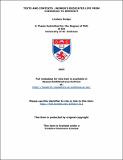Files in this item
Texts and contexts : women's dedicated life from Caesarius to Benedict
Item metadata
| dc.contributor.advisor | Mulchahey, Michelle | |
| dc.contributor.author | Rudge, Lindsay | |
| dc.coverage.spatial | 280 | en |
| dc.date.accessioned | 2007-04-05T14:18:32Z | |
| dc.date.available | 2007-04-05T14:18:32Z | |
| dc.date.issued | 2007-06-21 | |
| dc.identifier.uri | https://hdl.handle.net/10023/312 | |
| dc.description.abstract | The history of western monasticism in the early middle ages has traditionally been viewed as a continuous process of development. Women religious have been excluded from this discourse, although early work which ‘rediscovered’ female communities has been built on to place them in the mainstream of thinking about monasticism. However, one way of approaching religious women has been largely overlooked. The production and circulation of normative works by and for female communities is of prime importance for evidence of interaction between male and female traditions of dedicated life. This thesis examines these issues through the works of Caesarius of Arles (470-542). Although his rule’s importance as the first western regula written specifically for women has long been recognised, the subsequent use of his monastic writings has never been adequately explored. In addition to being the inspiration for a number of later rules, his work was given a new purpose as part of the reforming activities of Benedict of Aniane in the opening decades of the ninth century. It is between these two vitally important figures that my thesis is framed. For the first time, this study shows that a core selection of Caesarian writings circulated between their composition in the early sixth century and the dates of the earliest existing manuscripts in the early ninth. This has unexplored implications for the understanding of the literary basis of dedicated life for both sexes. The thesis has significance for the study of female religious communities in two areas. Firstly, the relative popularity of Caesarius’ texts over time is of great interest as an indicator of values placed on different aspects of his work. The second area of investigation is the apparent fluidity of the texts’ gender, and how, in brief, texts written for women could be used equally effectively for men. This research opens up a new way of thinking about the relationship between female and male dedicated life. It is no longer possible to conceive of religious dedication along strictly gendered lines. | en |
| dc.format.extent | 1333787 bytes | |
| dc.format.mimetype | application/pdf | |
| dc.language.iso | en | en |
| dc.publisher | University of St Andrews | |
| dc.rights | Creative Commons Attribution-NoDerivs 3.0 Unported | |
| dc.rights.uri | http://creativecommons.org/licenses/by-nd/3.0/ | |
| dc.subject | Monasticism | en |
| dc.subject.lcc | BX4210.R8 | |
| dc.subject.lcsh | Monastic and religious life of women--History--Early church, ca. 30-600. | en |
| dc.subject.lcsh | Monastic and religious life of women--History--Middle Ages, 600-1500. | en |
| dc.subject.lcsh | Monastic and religious life--Sex differences | en |
| dc.subject.lcsh | Caesarius, of Arles, Saint, 470-542. | en |
| dc.title | Texts and contexts : women's dedicated life from Caesarius to Benedict | en |
| dc.type | Thesis | en |
| dc.contributor.sponsor | Carnegie Trust for the Universities of Scotland | en |
| dc.contributor.sponsor | Institute of Historical Research | en |
| dc.type.qualificationlevel | Doctoral | en |
| dc.type.qualificationname | PhD Doctor of Philosophy | en |
| dc.publisher.institution | The University of St Andrews | en |
This item appears in the following Collection(s)
Except where otherwise noted within the work, this item's licence for re-use is described as Creative Commons Attribution-NoDerivs 3.0 Unported
Items in the St Andrews Research Repository are protected by copyright, with all rights reserved, unless otherwise indicated.


